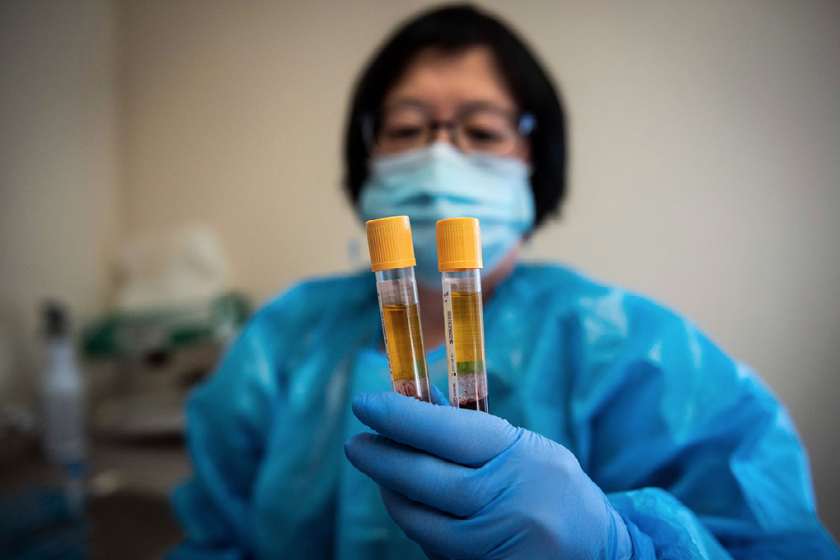On March 18, 2021, researchers from across UVM came together via Zoom for the second edition of the Translational Global Infectious Diseases Research Center's COVID-19 research slam, titled “UVM Tackles COVID-19: Research Progress and Perspectives One Year into the Pandemic.”

Cassandra Ventrone, research technician in UVM's Vaccine Testing Center, processes materials for the AstraZeneca COVID-19 vaccine trial. (Photo: Ryan Mercer, UVM Medical Center)
As the hub of infectious disease research at the Larner College of Medicine, the Translational Global Infectious Diseases Research (TGIR) Center proactively led a research slam about “2019-nCoV” – a quickly spreading novel coronavirus originating from Wuhan, China – in February 2020. Over the past 14 months since, basic scientists and clinicians from across the University of Vermont have conducted a total of 77 COVID-19 research projects. On March 18, 2021, the researchers came together again for the second edition of this gathering.
Titled “UVM Tackles COVID-19: Research Progress and Perspectives One Year into the Pandemic,” the research slam was organized and hosted via Zoom by TGIR Principal Investigator Beth Kirkpatrick, M.D., chair of microbiology and molecular genetics and director of the Vaccine Testing Center, and Kristen Pierce, M.D., professor of medicine and TGIR Health Population Research Core director. The 2021 event featured an opening presentation by Vermont Commissioner of Health Mark Levine, M.D., and keynote address on “How COVID-19 Has Changed the Field of Infectious Disease Modeling" by Caroline Buckee, Ph.D., associate professor of epidemiology and associate director of the Center for Communicable Disease Dynamics at the Harvard T.H. Chan School of Public Health.
Faculty from departments and colleges across the university concurrently delivered presentations during break-out sessions grouped in the following categories: Clinical/Translational Research (moderated by Dr. Pierce); Epidemiology and Public Health Section 1 (moderated by Dr. Kirkpatrick); Epidemiology and Public Health Section 2 (moderated by Jason Bates, Ph.D., D.Sc.); Basic Science (moderated by Christopher Huston, M.D.); Modeling (moderated by Dr. Buckee); and Environment/Climate/Ecology (moderated by E. Ross Colgate, Ph.D.). (Link to the full event agenda.)
“For many of us, the last year has been so difficult and at times frightening,” says Pierce. “The research slam was a chance for us to highlight and share details about the amazing research efforts that took place in response to the pandemic. And personally, it was wonderful to see so many of my colleagues’ faces on the other side of 2020.”
Among the Clinical/Translational Research session topics was a presentation by Mary Cushman, M.D., M.Sc., professor of medicine, about the Accelerating COVID-19 Therapeutic Interventions and Vaccines (ACTIV) initiative, and in particular the RAPID COVID COAG anticoagulation trial on which she served as an investigator. Cushman discussed details about the anticoagulation research effort, which featured what she called “harmonized protocols” delivered via multiple platforms to determine whether there was a greater benefit from administering full doses of blood thinners to moderately ill hospitalized patients with COVID-19. She noted that 32 percent of trial participants were Black or Hispanic – an important achievement in light of the disproportionate impact of COVID-19 on BIPOC communities. She also underscored the remarkably short timeframe between the launch of the ACTIV-4 Antithrombotics inpatient clinical trial in September 2020 and release of results – which found that full dose blood-thinning treatment reduced the need for such critical organ support as mechanical ventilation – in January 2021.
One of the research projects in the Epidemiology and Public Health Section 1 session was a presentation, titled "Healthcare worker COVID infection epidemiology," by Cindy Noyes, M.D., associate professor of medicine and director of infection prevention and hospital epidemiologist at the UVM Medical Center. This project highlighted protocols implemented at the medical center, including a designated COVID hotline and contact tracing process, and tracked the number of COVID-19-positive employees at the UVM Medical Center over time and in the context of the implementation of interventions like visitor restriction, universal masking for all staff and patients, the addition of eye protection, and employee vaccination.
Noyes pointed out that the medical center employee patterns of infection followed the state infection rates and noted that “probably the most impactful intervention was employee vaccination, which began on December 15,” and resulted in a marked decrease in cases one month later. Another interesting finding of the research was that of 193 COVID-19-positive employees, 126 or 65 percent were community-acquired, non-work-related infections.
Presenters included medical students and faculty representing departments and programs, including biology; biomedical and health sciences; civil and environmental engineering; environmental sciences; family medicine; geography; medicine; microbiology and molecular genetics; nutrition and food sciences; pathology and laboratory medicine; pediatrics; and surgery.